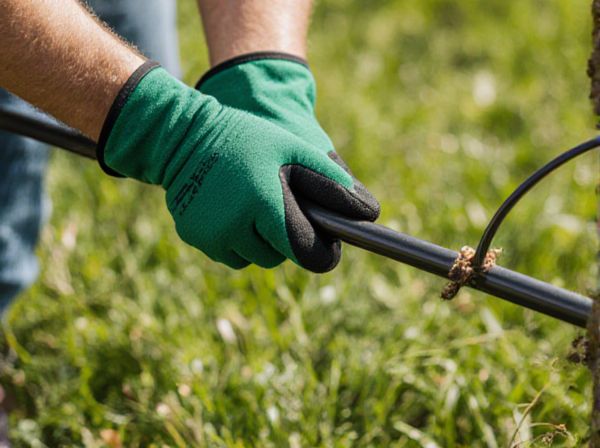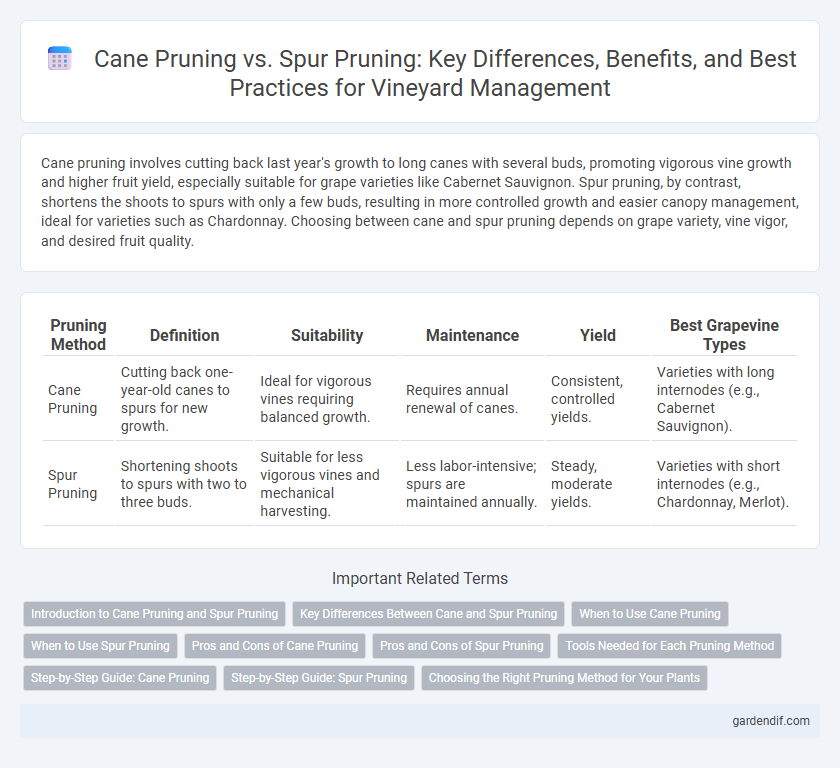
Cane pruning vs spur pruning Illustration
Cane pruning involves cutting back last year's growth to long canes with several buds, promoting vigorous vine growth and higher fruit yield, especially suitable for grape varieties like Cabernet Sauvignon. Spur pruning, by contrast, shortens the shoots to spurs with only a few buds, resulting in more controlled growth and easier canopy management, ideal for varieties such as Chardonnay. Choosing between cane and spur pruning depends on grape variety, vine vigor, and desired fruit quality.
Table of Comparison
| Pruning Method | Definition | Suitability | Maintenance | Yield | Best Grapevine Types |
|---|---|---|---|---|---|
| Cane Pruning | Cutting back one-year-old canes to spurs for new growth. | Ideal for vigorous vines requiring balanced growth. | Requires annual renewal of canes. | Consistent, controlled yields. | Varieties with long internodes (e.g., Cabernet Sauvignon). |
| Spur Pruning | Shortening shoots to spurs with two to three buds. | Suitable for less vigorous vines and mechanical harvesting. | Less labor-intensive; spurs are maintained annually. | Steady, moderate yields. | Varieties with short internodes (e.g., Chardonnay, Merlot). |
Introduction to Cane Pruning and Spur Pruning
Cane pruning involves selecting long, single-year-old canes and training them horizontally along the trellis, promoting vigorous growth and high-quality fruit production in grapevines. Spur pruning concentrates on cutting back canes to short spurs with two to three buds, encouraging the development of fruitful shoots close to the main vine structure. Both methods impact vine vigor, fruit yield, and cluster size, with cane pruning suited for varieties requiring renewed fruiting wood and spur pruning preferred for consistent, moderate growth.
Key Differences Between Cane and Spur Pruning
Cane pruning involves cutting back the previous year's growth to long, flexible canes with multiple buds, promoting vigorous shoots and larger grape clusters ideal for vigorous vines. Spur pruning retains short spurs with two to three buds each near the main trunk, encouraging controlled growth and consistent fruit production suited for less vigorous or mature vines. Key differences include cane pruning's emphasis on renewal and flexibility versus spur pruning's stable, simplified structure offering easier maintenance and predictable yields.
When to Use Cane Pruning
Cane pruning is ideal for grapevine varieties with long, vigorous canes that produce fruit primarily on new wood, such as Concord or Niagara. This method is typically used to manage growth and optimize fruit quality in young or heavily productive vines by retaining a few strong canes for the coming season. It is most beneficial in vineyards where controlling excessive bud fruitfulness is necessary to prevent overcrowding and ensure better airflow.
When to Use Spur Pruning
Spur pruning is ideal for grapevine varieties with short fruiting spurs, such as Chardonnay and Cabernet Sauvignon, where maintaining a permanent framework is crucial. This method encourages consistent bud fruitfulness and simplifies annual maintenance, making it suitable for densely planted vineyards. Use spur pruning in climates with predictable growing seasons to optimize yield and fruit quality.
Pros and Cons of Cane Pruning
Cane pruning offers precise control over vine growth and can improve fruit quality by encouraging stronger shoots and better sunlight exposure. However, it requires more labor and skill to execute correctly, increasing vineyard management costs. The method also risks reduced yield if canes are not properly selected, making it less forgiving than spur pruning.
Pros and Cons of Spur Pruning
Spur pruning encourages consistent grape yield by preserving short, productive shoots, which enhances vine health and fruit quality over time. This method reduces labor intensity compared to cane pruning but can limit canopy airflow, increasing the risk of fungal diseases in humid climates. Spur pruning is most effective for grape varieties with fruitful renewal spurs and well-established trellising systems.
Tools Needed for Each Pruning Method
Cane pruning requires sharp hand pruners, loppers, and sometimes a pruning saw to cut thicker, older canes, ensuring clean cuts for optimal vine health. Spur pruning typically utilizes hand pruners and small loppers, as it involves cutting short spurs close to the main branches, demanding precision over power. Both methods benefit from well-maintained tools to prevent disease transmission and promote rapid healing of pruning wounds.
Step-by-Step Guide: Cane Pruning
Cane pruning involves selecting 1 to 4 healthy canes from the previous season's growth, each with ample buds, and cutting them back to 8-15 buds per cane to promote optimal fruit production. Begin by removing old, unproductive wood and thinning the vine to improve sunlight exposure and air circulation, which reduces disease risk. Secure the chosen canes horizontally along the trellis wire, ensuring even spacing to facilitate maintenance and harvesting.
Step-by-Step Guide: Spur Pruning
Spur pruning involves cutting back last year's growth to short spurs with two to four buds, promoting controlled fruit production and easier maintenance. Begin by removing all old wood except for selected one-year-old canes, then trim these canes to spurs with evenly spaced buds to ensure balanced growth. Focus on maintaining an open canopy by cutting back crowded shoots and preserving strong, well-positioned spurs for optimal grape yield and quality.
Choosing the Right Pruning Method for Your Plants
Selecting the appropriate pruning method depends on the plant species, growth habits, and desired yield. Cane pruning suits vigorous grapevines with long canes, promoting optimal fruit production and ease of maintenance. Spur pruning is ideal for fruit trees and grapevines with short fruiting shoots, enhancing structural strength and encouraging consistent bud growth.
Cane pruning vs spur pruning Infographic

 gardendif.com
gardendif.com